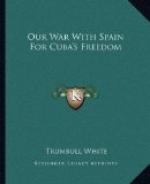The Spanish set a trap one day during the blockade. The wily Spaniards arranged a trap to send a couple of our ships to the bottom. A small schooner was sent out from Havana harbor to draw some of the Americans into the ambuscade. The ruse worked like a charm. The Vicksburg and the Morrill, in the heat of the chase and in their contempt for Spanish gunnery, walked straight into the trap that had been set for them. Had the Spaniards possessed their souls in patience but five minutes longer, not even their bad gun practice would have saved our ships, and two more of our vessels would lie at the bottom within two lengths of the wreck of the ill-starred Maine.
Friday evening the Vicksburg and the Morrill, cruising to the west of Morro Castle, were fired on by the big guns of the Cojimar batteries. Two shots were fired at the Vicksburg and one at the Morrill. Both fell short, and both vessels, without returning the fire, steamed out of range. It would have been folly to have done otherwise. But this time the Spaniards had better luck. The schooner they had sent out before daylight ran off to the eastward, hugging the shore, with the wind on her starboard quarter. About three miles east of the entrance to the harbor she came over on the port tack. A light haze fringed the horizon and she was not discovered until three miles off shore, when the Mayflower made her out and signaled the Morrill and Vicksburg.
They take the bait.
Captain Smith, of the Morrill, and Commander Lilly, of the Vicksburg, immediately slapped on all steam and started in pursuit. The schooner instantly put about and ran for Morro Castle before the wind. By doing so she would, according to the well-conceived Spanish plot, lead the two American warships directly under the guns of the Santa Clara batteries. These works are a short mile west of Morro, and are a part of the defenses of the harbor. There are two batteries, one at the shore, which has been recently thrown up, of sand and mortar, with wide embrasures for eight-inch guns, and the other on the crest of the rocky eminence which juts out into the water of the gulf at the point.
The upper battery mounts modern 10-inch and 12-inch Krupp guns behind a six-foot stone parapet, in front of which are twenty feet of earthwork and a belting of railroad iron. This battery is considered the most formidable of Havana’s defenses except Morro Castle. It is masked and has not been absolutely located by the American warships. It is probably due to the fact that the Spanish did not desire to expose its position that the Vicksburg and Morrill are now afloat.
The Morrill and Vicksburg were about six miles from the schooner when the chase began. They steamed after her at full speed, the Morrill leading until within a mile and a half of the Santa Clara batteries. Commander Smith, of the Vicksburg, was the first to realize the danger into which the reckless pursuit had led them. He concluded it was time to haul off and sent a shot across the bow of the schooner.




